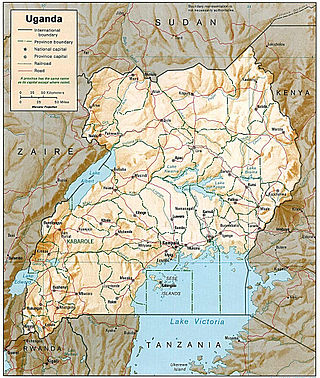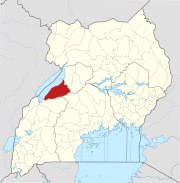
Transport in Uganda refers to the transportation structure in Uganda. The country has an extensive network of paved and unpaved roads.
Hoima is a city in the Western Region of Uganda. It is the main municipal, administrative, and commercial center of Hoima District. It is also the location of the palace of the Omukama of Bunyoro.

Burning of renewable resources provides approximately 90 percent of the energy in Uganda, though the government is attempting to become energy self-sufficient. While much of the hydroelectric potential of the country is untapped, the government decision to expedite the creation of domestic petroleum capacity coupled with the discovery of large petroleum reserves holds the promise of a significant change in Uganda's status as an energy-importing country.
Kabalega Hydroelectric Power Station, also known as Kabalega Power Station is a 9 MW (12,000 hp) mini hydroelectric power project located across River Wambabya, in Buseruka Sub County, Hoima District, in Western Uganda. At the beginning of planning and during construction, the power station was referred to as Buseruka Power Station, but was renamed after completion.
The Karuma Hydroelectric Power Station is a 600 MW hydroelectric power project under construction in Uganda. When completed, it will be the largest power-generating installation in the country.
Kikagati Hydroelectric Power Station, also referred to as Kikagati Power Station, is a 15.57 MW (20,880 hp) hydroelectric power station, in Uganda.
Nzizi Power Station is a planned 100 MW (130,000 hp) natural gas-fired thermal power plant in Uganda.
The Uganda Oil Refinery is a planned crude oil refinery in Kabaale village, on the Eastern shore of Lake Albert along the Hoima–Kaiso–Tonya Road, Buseruka Sub-county, Hoima District, Western Region, Uganda, near the border with the Democratic Republic of the Congo. It has been planned since 2010. Community opposition was repressed early on. After 5 years of negotiations the Albertine Graben Refinery Consortium (AGRC) formed in 2018 and agreed to design and build the refinery.
The Uganda National Oil Company (UNOC), also known as the National Oil Company of Uganda, is a limited liability petroleum company in Uganda owned by the Ugandan government. The 2013 Petroleum Act of Uganda provides for the establishment of the national oil company. UNOC's board of directors was inaugurated on 23 October 2015 by the president of Uganda.
The Kenya–Uganda–Rwanda Petroleum Products Pipeline is a pipeline that carries refined petroleum products from the Kenyan port city of Mombasa to the country's capital of Nairobi and continues to the town of Eldoret in the Eastern Rift Valley. There are plans to extend the pipeline to Uganda's capital, Kampala, continuing on to Rwanda's capital, Kigali.
Hoima–Kaiso–Tonya Road is a road in the Western Region of Uganda, connecting the city of Hoima with the towns of Kaiso and Tonya on the shores of Lake Albert in the oil-rich Albertine Graben.
The Hoima–Kampala Petroleum Products Pipeline (HKPPP) is a proposed pipeline to transport refined oil products from the Uganda Oil Refinery in Hoima to a distribution terminal near Buloba in Wakiso District, approximately 28 kilometres (17 mi), by road, west of Kampala's central business district.
Hoima–Butiaba–Wanseko Road is a road in the Western Region of Uganda, connecting the city of Hoima and the towns of Butiaba, Buliisa, and Wanseko on the shores of Lake Albert. This is one of Uganda's critical oil roads because it facilitates oil exploration in the Albertine Graben, as well as tourism, due to its proximity to Kabalega National Park.
The Kyenjojo–Kabwoya Road, in the Western Region of Uganda, connects the town of Kyenjojo in the Kyenjojo District with Kabwoya in the Hoima District. The road is part of the 238 kilometres (148 mi) Kyenjojo–Hoima–Masindi–Kigumba road corridor.

The East African Crude Oil Pipeline (EACOP), also known as the Uganda–Tanzania Crude Oil Pipeline (UTCOP), is a 1,443 km crude oil pipeline in planning since 2013, with a foundation stone nominally under construction since 2017 and intended to transport crude oil from Uganda's Tilenga and Kingfisher oil fields to the Port of Tanga, Tanzania on the Indian Ocean.
Kasenyi is a village in Ngedwo sub county, Buliisa District, in the Western Region of Uganda. It is the location of a "central processing facility" (CPF) of Uganda's oil fields in the Albertine Graben.
Pauline Irene Batebe also Irene Pauline Batebe or Irene Batebe, is a Ugandan chemical and mechanical engineer, who serves as the Permanent Secretary in the Uganda Ministry of Energy and Mineral Development, since August 2021.
Albertine Graben Refinery Consortium (AGRC), is a consortium of 4 international companies which agreed in 2018 with the government of Uganda, to invest in, construct, operate and co-own the Uganda Oil Refinery on the Eastern shore of Lake Albert. It consists of General Electric of the United States, Yaatra Ventures LLC of the United States, Intracontinent Asset Holdings Limited of Mauritius and Saipem SPA of Italy.
Masindi–Biso Road is a road in the Western Region of Uganda, connecting the city of Masindi, in Masindi District and the town of Biso, in Buliisa District in the oil-rich Albertine Graben.
The Hoima–Kinyara–Kafu High Voltage Power Line is a planned high voltage electricity power line, connecting the high voltage substation at Kabaale, Buseruka sub-county, Hoima District, in the Western Region of Uganda to another high voltage substation at Kafu, Nakasongola District, in the Central Region of Uganda. On the way, the power line passes through Kinyara Sugar Works, in Masindi District.




